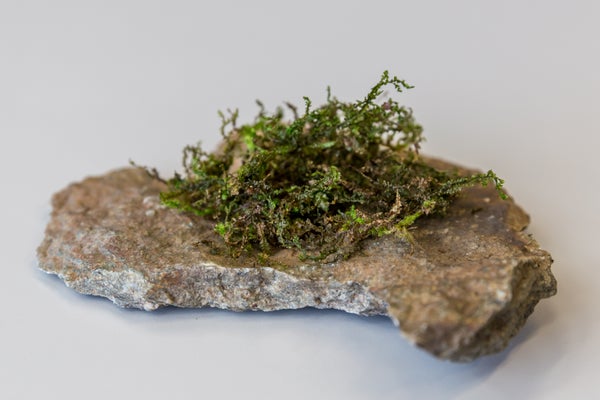Several hundred million years ago mosses and their kin went one way, evolutionarily speaking, and the lineage of trees and flowering plants went the other. Somehow, in the vast expanse of geologic time that followed, a few members of these distantly related groups in the plant kingdom copied one another in making something of great interest to humans: the psychoactive chemical, or cannabinoid, that gets people high.
The recent discovery of another source of a cannabinoid comes from a plant that is a relative of the mosses called liverwort. One genus of the plant, Radula, boasts a handful of species that produce a chemical that is a lot like tetrahydrocannabinol (THC) from Cannabis sativa, or marijuana.
Why a liverwort, which lives and reproduces quite differently from a plant like Cannabis, would make this molecule remains a mystery. What we now know, however, is the cannabinoid from liverwort and the one in Cannabis are almost exactly the same and have quite similar effects in the mammalian brain.
On supporting science journalism
If you're enjoying this article, consider supporting our award-winning journalism by subscribing. By purchasing a subscription you are helping to ensure the future of impactful stories about the discoveries and ideas shaping our world today.
The Radula compound has been dubbed perrottetinene, or PET, after Radula perrottetii, one of the few liverwort species that makes it. Although researchers first described perrottetinene in 1994, how it compared with THC in structure and activity in mammalian brains did not become clear until now.
In what may be the only chemical synthesis paper ever to thank incense sellers in its acknowledgments, Jürg Gertsch of the University of Bern and colleagues confirmed the properties of PET that make it similar to THC. Publishing October 24 in Science Advances, the researchers show through a variety of tests that PET from these Radula species looks and acts a lot like THC from Cannabis. “Curiosity-driven research can lead to interesting results,” says Daniele Piomelli, professor of anatomy and neurobiology at the University of California, Irvine, who was not involved in the study. “This is solid work, very credible, showing that this type of liverwort contains compounds that are akin both in structure and pharmaceutical activity to psychoactive cannabinoids in the cannabis plant.”
To establish this strong similarity, the investigators synthesized forms of PET based on the naturally occurring compound. Using cell preparations, the research team checked to see if the PET molecules bound to the same brain receptors in the cell membrane as THC—and they do. They also checked to see if the PETs bound brain proteins that THC doesn’t—they don’t.
The team then examined how PET and THC compare in potency, and found PET to be less potent. They also discovered THC-like effects when PET was administered to mice—the animals responded similarly to both treatments, including moving more slowly and having lower body temperatures.
When the researchers evaluated the effects of PET compared with THC on inflammation pathways in mouse brains, they finally found a difference. Although PET’s psychoactive effects were less potent, it reduced certain molecules associated with inflammation, says study author Michael Schafroth, currently a postdoctoral researcher at The Scripps Research Institute.
In contrast, THC did not tamp down levels of these inflammation-related molecules, called prostaglandins. “These prostaglandins are involved in many processes (such as) memory loss, neuroinflammation, hair loss and vasoconstriction,” he says. That means PET is “highly interesting for medicinal applications, as we can expect fewer adverse effects while still having pharmacologically important effects.” The reduced potency of PET also might put a damper on any interest in the liverwort for recreational use, especially in an era of increasingly loosened cannabis regulation.
Radula samples were available from the incense sellers the authors thanked in their acknowledgments. But scattered online descriptions from people who have tried it to get high suggest limited success. And because liverworts reproduce without using seeds, “the cultivation and reproduction of Radula species containing the cannabinoid might be challenging,” Gertsch says. The pharmaceutical promise of liverwort could mean a higher profile for the modest moss and its kin, known collectively as bryophytes. “To date, bryophytes are a bit neglected in terms of bio-prospecting,” he notes, referring to the search for organisms that might have medicinal value. “I think this is a great example that liverworts can generate natural products of relevance to humans.”
It may already have been relevant to the people who live where these species of Radula occur naturally, which are as far afield as Japan, New Zealand and Costa Rica. There are hints that the Maori people of New Zealand use it as an herbal medicine, although not necessarily for its THC-like properties. Gertsch adds, however, that no serious ethnobotanical or ethnopharmacological research confirms such uses.
With a synthetic means to make this compound now established, the next step will be to investigate it in animal models of inflammatory diseases such as multiple sclerosis, Gertsch says, directly comparing it with the activity of THC.
